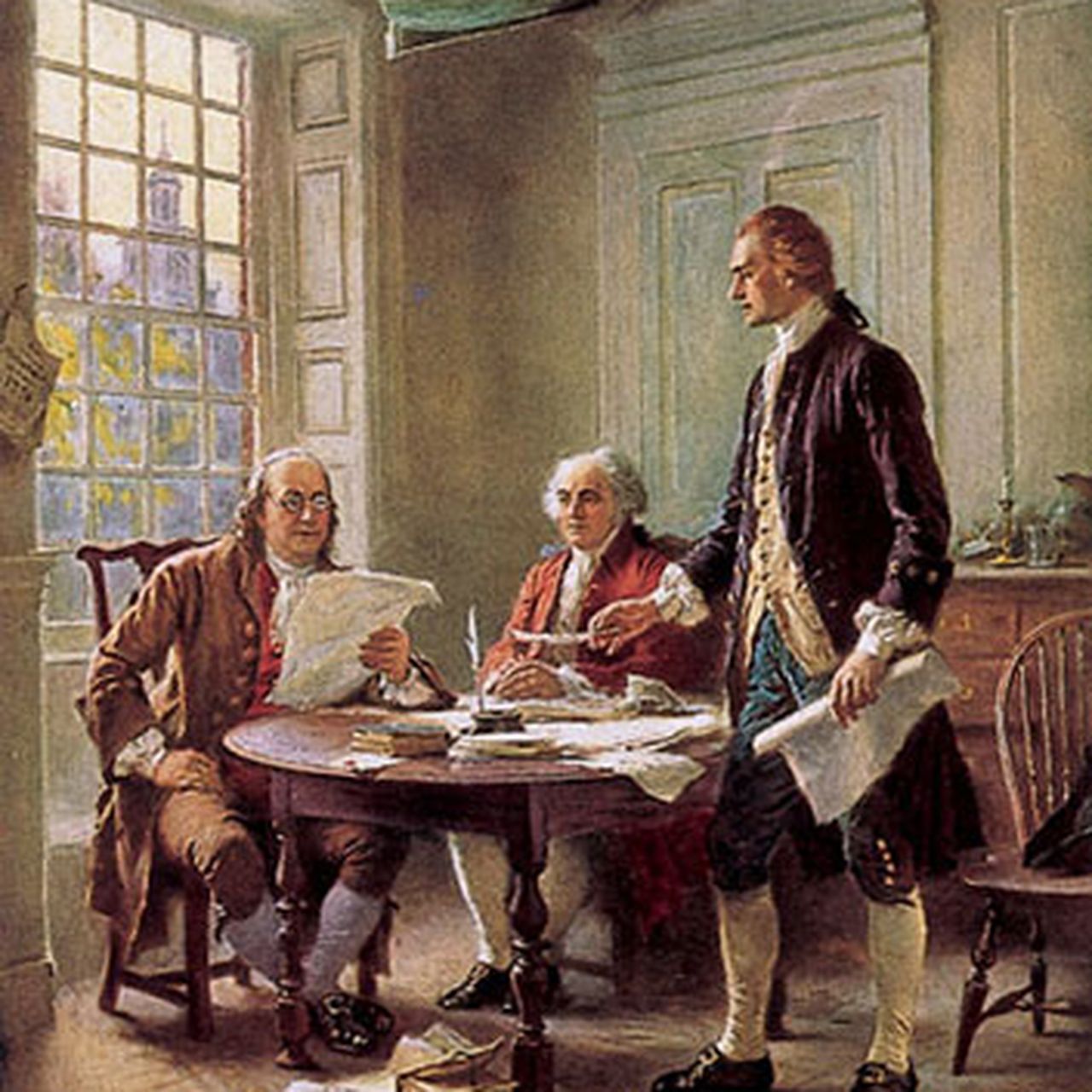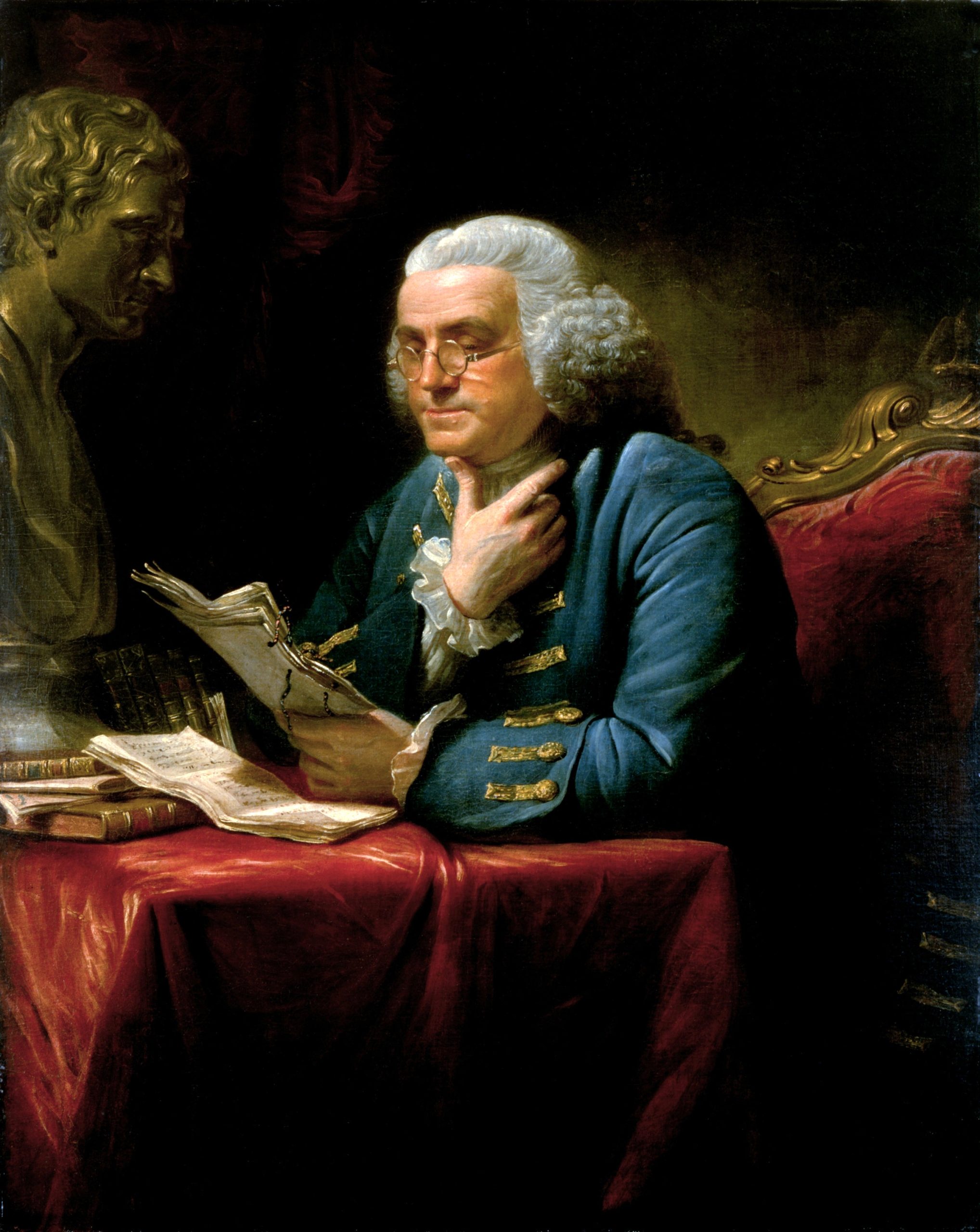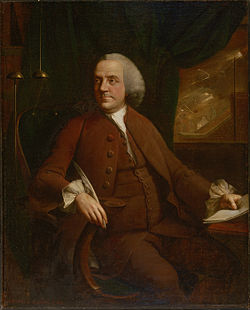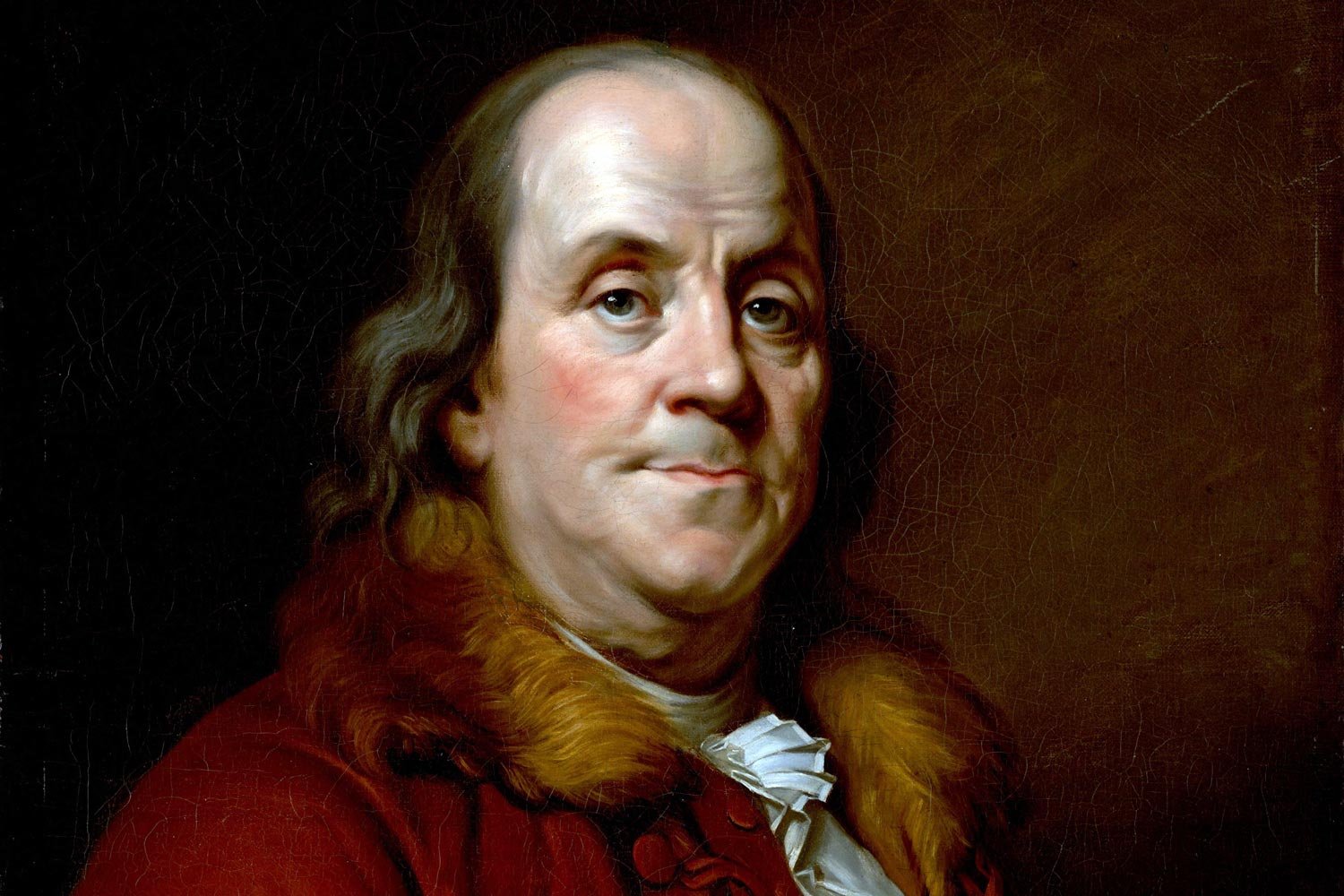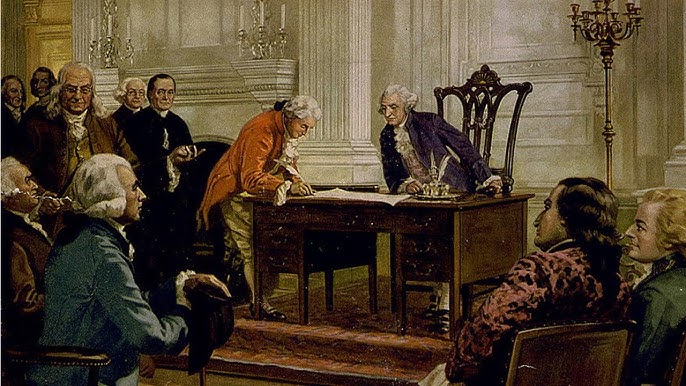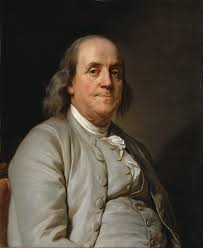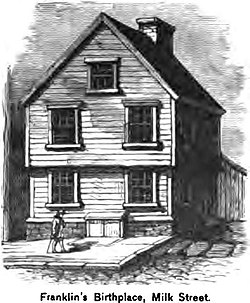Born in the Province of Massachusetts Bay, Franklin became a successful newspaper editor and printer in Philadelphia, the leading city in the colonies, publishing The Pennsylvania Gazette at age 23. He became wealthy publishing this and Poor Richard’s Almanack, which he wrote under the pseudonym “Richard Saunders”. After 1767, he was associated with the Pennsylvania Chronicle, a newspaper known for its revolutionary sentiments and criticisms of the policies of the British Parliament and the Crown. He pioneered and was the first president of the Academy and College of Philadelphia, which opened in 1751 and later became the University of Pennsylvania. He organized and was the first secretary of the American Philosophical Society and was elected its president in 1769. He was appointed deputy postmaster-general for the British colonies in 1753, which enabled him to set up the first national communications network.
Franklin was active in community affairs and colonial and state politics, as well as national and international affairs. He became a hero in America when, as an agent in London for several colonies, he spearheaded the repeal of the unpopular Stamp Act by the British Parliament. An accomplished diplomat, he was widely admired as the first U.S. ambassador to France and was a major figure in the development of positive Franco–American relations. His efforts proved vital in securing French aid for the American Revolution. From 1785 to 1788, he served as President of Pennsylvania. At some points in his life, he owned slaves and ran “for sale” ads for slaves in his newspaper, but by the late 1750s, he began arguing against slavery, became an active abolitionist, and promoted the education and integration of African Americans into U.S. society.
As a scientist, Franklin’s studies of electricity made him a major figure in the American Enlightenment and the history of physics. He also charted and named the Gulf Stream current. His numerous important inventions include the lightning rod, bifocals, glass harmonica and the Franklin stove. He founded many civic organizations, including the Library Company, Philadelphia’s first fire department, and the University of Pennsylvania. Franklin earned the title of “The First American” for his early and indefatigable campaigning for colonial unity. He was the only person to sign the Declaration of Independence, the Treaty of Paris peace with Britain, and the Constitution. Foundational in defining the American ethos, Franklin has been called “the most accomplished American of his age and the most influential in inventing the type of society America would become”.
Franklin’s life and legacy of scientific and political achievement, and his status as one of America’s most influential Founding Fathers, have seen him honored for more than two centuries after his death on the $100 bill and in the names of warships, many towns and counties, educational institutions and corporations, as well as in numerous cultural references and a portrait in the Oval Office. His more than 30,000 letters and documents have been collected in The Papers of Benjamin Franklin. Anne Robert Jacques Turgot said of him: “Eripuit fulmen cœlo, mox sceptra tyrannis” (“He snatched lightning from the sky and the scepter from tyrants”).
Ancestry
Benjamin Franklin’s father, Josiah Franklin, was a tallow chandler, soaper, and candlemaker. Josiah Franklin was born at Ecton, Northamptonshire, England, on December 23, 1657, the son of Thomas Franklin, a blacksmith and farmer, and his wife, Jane White. Benjamin’s father and all four of his grandparents were born in England.
Josiah Franklin had a total of seventeen children with his two wives. He married his first wife, Anne Child, in about 1677 in Ecton and emigrated with her to Boston in 1683; they had three children before emigration and four after. Following her death, Josiah married Abiah Folger on July 9, 1689, in the Old South Meeting House by Reverend Samuel Willard, and had ten children with her. Benjamin, their eighth child, was Josiah Franklin’s fifteenth child overall, and his tenth and final son.
Benjamin Franklin’s mother, Abiah, was born in Nantucket, Massachusetts Bay Colony, on August 15, 1667, to Peter Folger, a miller and schoolteacher, and his wife, Mary Morrell Folger, a former indentured servant. Mary Folger came from a Puritan family that was among the first Pilgrims to flee to Massachusetts for religious freedom, sailing for Boston in 1635 after King Charles I of England had begun persecuting Puritans. Her father Peter was “the sort of rebel destined to transform colonial America.” As clerk of the court, he was arrested on February 10, 1676, and jailed on February 19 for his inability to pay bail. He spent over a year and a half in jail.
Early life and education
Boston
Franklin was born on Milk Street in Boston, Province of Massachusetts Bay on January 17, 1706, and baptized at the Old South Meeting House in Boston. As a child growing up along the Charles River, Franklin recalled that he was “generally the leader among the boys.”
Franklin’s father wanted him to attend school with the clergy but only had enough money to send him to school for two years. He attended Boston Latin School but did not graduate; he continued his education through voracious reading. Although “his parents talked of the church as a career” for Franklin, his schooling ended when he was ten. He worked for his father for a time, and at 12 he became an apprentice to his brother James, a printer, who taught him the printing trade. When Benjamin was 15, James founded The New-England Courant, which was the third newspaper founded in Boston.
When denied the chance to write a letter to the paper for publication, Franklin adopted the pseudonym of “Silence Dogood”, a middle-aged widow. Mrs. Dogood’s letters were published and became a subject of conversation around town. Neither James nor the Courant‘s readers were aware of the ruse, and James was unhappy with Benjamin when he discovered the popular correspondent was his younger brother. Franklin was an advocate of free speech from an early age. When his brother was jailed for three weeks in 1722 for publishing material unflattering to the governor, young Franklin took over the newspaper and had Mrs. Dogood proclaim, quoting Cato’s Letters, “Without freedom of thought there can be no such thing as wisdom and no such thing as public liberty without freedom of speech.” Franklin left his apprenticeship without his brother’s permission, and in so doing became a fugitive.
Moves to Philadelphia and London
At age 17, Franklin ran away to Philadelphia, seeking a new start in a new city. When he first arrived, he worked in several printing shops there, but he was not satisfied by the immediate prospects in any of these jobs. After a few months, while working in one printing house, Pennsylvania governor Sir William Keith convinced him to go to London, ostensibly to acquire the equipment necessary for establishing another newspaper in Philadelphia. Discovering that Keith’s promises of backing a newspaper were empty, he worked as a typesetter in a printer’s shop in what is today the Lady Chapel of Church of St Bartholomew-the-Great in the Smithfield area of London, which had at that time been deconsecrated. He returned to Philadelphia in 1726 with the help of Thomas Denham, an English merchant who had emigrated but returned to England, and who employed Franklin as a clerk, shopkeeper, and bookkeeper in his business.
Junto and library

In 1727, at age 21, Franklin formed the Junto, a group of “like minded aspiring artisans and tradesmen who hoped to improve themselves while they improved their community.” The Junto was a discussion group for issues of the day; it subsequently gave rise to many organizations in Philadelphia. The Junto was modeled after English coffeehouses that Franklin knew well and which had become the center of the spread of Enlightenment ideas in Britain.
Reading was a great pastime of the Junto, but books were rare and expensive. The members created a library, initially assembled from their own books, after Franklin wrote:
A proposition was made by me that since our books were often referr’d to in our disquisitions upon the inquiries, it might be convenient for us to have them altogether where we met, that upon occasion they might be consulted; and by thus clubbing our books to a common library, we should, while we lik’d to keep them together, have each of us the advantage of using the books of all the other members, which would be nearly as beneficial as if each owned the whole.
This did not suffice, however. Franklin conceived the idea of a subscription library, which would pool the funds of the members to buy books for all to read. This was the birth of the Library Company of Philadelphia, whose charter he composed in 1731.
Newspaperman

Upon Denham’s death, Franklin returned to his former trade. In 1728, he set up a printing house in partnership with Hugh Meredith; the following year he became the publisher of The Pennsylvania Gazette, a newspaper in Philadelphia. The Gazette gave Franklin a forum for agitation about a variety of local reforms and initiatives through printed essays and observations. Over time, his commentary, and his adroit cultivation of a positive image as an industrious and intellectual young man, earned him a great deal of social respect. But even after he achieved fame as a scientist and statesman, he habitually signed his letters with the unpretentious ‘B. Franklin, Printer’.
In 1732, he published the first German-language newspaper in America – Die Philadelphische Zeitung – although it failed after only one year because four other newly founded German papers quickly dominated the newspaper market. Franklin also printed Moravian religious books in German. He often visited Bethlehem, Pennsylvania, staying at the Moravian Sun Inn. In a 1751 pamphlet on demographic growth and its implications for the Thirteen Colonies, he called the Pennsylvania Germans “Palatine Boors” who could never acquire the “Complexion” of Anglo-American settlers and referred to “Blacks and Tawneys” as weakening the social structure of the colonies. Although he apparently reconsidered shortly thereafter, and the phrases were omitted from all later printings of the pamphlet, his views may have played a role in his political defeat in 1764.
According to Ralph Frasca, Franklin promoted the printing press as a device to instruct colonial Americans in moral virtue. Frasca argues he saw this as a service to God, because he understood moral virtue in terms of actions, thus, doing good provides a service to God. Despite his own moral lapses, Franklin saw himself as uniquely qualified to instruct Americans in morality. He tried to influence American moral life through the construction of a printing network based on a chain of partnerships from the Carolinas to New England. He thereby invented the first newspaper chain. It was more than a business venture, for like many publishers he believed that the press had a public-service duty.
When he established himself in Philadelphia, shortly before 1730, the town boasted two “wretched little” news sheets, Andrew Bradford’s The American Weekly Mercury and Samuel Keimer’s Universal Instructor in all Arts and Sciences, and Pennsylvania Gazette. This instruction in all arts and sciences consisted of weekly extracts from Chambers’s Universal Dictionary. Franklin quickly did away with all of this when he took over the Instructor and made it The Pennsylvania Gazette. The Gazette soon became his characteristic organ, which he freely used for satire, for the play of his wit, even for sheer excess of mischief or of fun. From the first, he had a way of adapting his models to his own uses. The series of essays called “The Busy-Body”, which he wrote for Bradford’s American Mercury in 1729, followed the general Addisonian form, already modified to suit homelier conditions. The thrifty Patience, in her busy little shop, complaining of the useless visitors who waste her valuable time, is related to the women who address Mr. Spectator. The Busy-Body himself is a true Censor Morum, as Isaac Bickerstaff had been in the Tatler. And a number of the fictitious characters, Ridentius, Eugenius, Cato, and Cretico, represent traditional 18th-century classicism. Franklin even used this classical framework for contemporary satire, as seen in the character of Cretico, the “sour Philosopher”, who is clearly a caricature of his rival, Samuel Keimer.
Franklin had mixed success in his plan to establish an inter-colonial network of newspapers that would produce a profit for him and disseminate virtue. Over the years he sponsored two dozen printers in Pennsylvania, South Carolina, New York, Connecticut, and even the Caribbean. By 1753, eight of the fifteen English language newspapers in the colonies were published by him or his partners. He began in Charleston, South Carolina, in 1731. After his second editor died, the widow, Elizabeth Timothy, took over and made it a success. She was one of the colonial era’s first woman printers. For three decades Franklin maintained a close business relationship with her and her son Peter Timothy, who took over the South Carolina Gazette in 1746. The Gazette was impartial in political debates, while creating the opportunity for public debate, which encouraged others to challenge authority. Timothy avoided blandness and crude bias and, after 1765, increasingly took a patriotic stand in the growing crisis with Great Britain. Franklin’s Connecticut Gazette (1755–68), however, proved unsuccessful. As the Revolution approached, political strife slowly tore his network apart.
Freemasonry
In 1730 or 1731, Franklin was initiated into the local Masonic lodge. He became a grand master in 1734, indicating his rapid rise to prominence in Pennsylvania. The same year, he edited and published the first Masonic book in the Americas, a reprint of James Anderson’s Constitutions of the Free-Masons. He was the secretary of St. John’s Lodge in Philadelphia from 1735 to 1738.
In January 1738, “Franklin appeared as a witness” in a manslaughter trial against two men who killed “a simple-minded apprentice” named Daniel Rees in a fake Masonic initiation gone wrong. One of the men “threw, or accidentally spilled, the burning spirits, and Daniel Rees died of his burns two days later.” While Franklin did not directly participate in the hazing that led to Rees’ death, he knew of the hazing before it turned fatal, and did nothing to stop it. He was criticized for his inaction in The American Weekly Mercury, by his publishing rival Andrew Bradford. Ultimately, “Franklin replied in his own defense in the Gazette.”
Franklin remained a Freemason for the rest of his life.
Common-law marriage to Deborah Read
At age 17 in 1723, Franklin proposed to 15-year-old Deborah Read while a boarder in the Read home. At that time, Deborah’s mother was wary of allowing her young daughter to marry Franklin, who was on his way to London at Governor Keith’s request, and also because of his financial instability. Her own husband had recently died, and she declined Franklin’s request to marry her daughter.
Franklin travelled to London, and after he failed to communicate as expected with Deborah and her family, they interpreted his long silence as a breaking of his promises. At the urging of her mother, Deborah married a potter named John Rogers on August 5, 1725. John soon fled to Barbados with her dowry in order to avoid debts and prosecution. Since Rogers’ fate was unknown, bigamy laws prevented Deborah from remarrying.
Franklin returned in 1726 and resumed his courtship of Deborah. They established a common-law marriage on September 1, 1730. They took in his recently acknowledged illegitimate young son and raised him in their household. They had two children together. Their son, Francis Folger Franklin, was born in October 1732 and died of smallpox in 1736. Their daughter, Sarah “Sally” Franklin, was born in 1743 and eventually married Richard Bache.
Deborah’s fear of the sea meant that she never accompanied Franklin on any of his extended trips to Europe; another possible reason why they spent much time apart is that he may have blamed her for possibly preventing their son Francis from being inoculated against the disease that subsequently killed him. Deborah wrote to him in November 1769, saying she was ill due to “dissatisfied distress” from his prolonged absence, but he did not return until his business was done. Deborah Read Franklin died of a stroke on December 14, 1774, while Franklin was on an extended mission to Great Britain; he returned in 1775.
William Franklin

In 1730, 24-year-old Franklin publicly acknowledged his illegitimate son William and raised him in his household. William was born on February 22, 1730, but his mother’s identity is unknown. He was educated in Philadelphia and beginning at about age 30 studied law in London in the early 1760s. William himself fathered an illegitimate son, William Temple Franklin, born on the same day and month: February 22, 1760. The boy’s mother was never identified, and he was placed in foster care. In 1762, the elder William Franklin married Elizabeth Downes, daughter of a planter from Barbados, in London. In 1763, he was appointed as the last royal governor of New Jersey.
A Loyalist to the king, William Franklin saw his relations with father Benjamin eventually break down over their differences about the American Revolutionary War, as Benjamin Franklin could never accept William’s position. Deposed in 1776 by the revolutionary government of New Jersey, William was placed under house arrest at his home in Perth Amboy for six months. After the Declaration of Independence, he was formally taken into custody by order of the Provincial Congress of New Jersey, an entity which he refused to recognize, regarding it as an “illegal assembly.” He was incarcerated in Connecticut for two years, in Wallingford and Middletown, and, after being caught surreptitiously engaging Americans into supporting the Loyalist cause, was held in solitary confinement at Litchfield for eight months. When finally released in a prisoner exchange in 1778, he moved to New York City, which was occupied by the British at the time.
While in New York City, he became leader of the Board of Associated Loyalists, a quasi-military organization chartered by King George III and headquartered in New York City. They initiated guerrilla forays into New Jersey, southern Connecticut, and New York counties north of the city. When British troops evacuated from New York, William Franklin left with them and sailed to England. He settled in London, never to return to North America. In the preliminary peace talks in 1782 with Britain, “… Benjamin Franklin insisted that loyalists who had borne arms against the United States would be excluded from this plea (that they be given a general pardon). He was undoubtedly thinking of William Franklin.”
Success as an author

In 1732, Franklin began to publish the noted Poor Richard’s Almanack (with content both original and borrowed) under the pseudonym Richard Saunders, on which much of his popular reputation is based. He frequently wrote under pseudonyms. The first issue published was for the upcoming year, 1733. He had developed a distinct, signature style that was plain, pragmatic and had a sly, soft but self-deprecating tone with declarative sentences. Although it was no secret that he was the author, his Richard Saunders character repeatedly denied it. “Poor Richard’s Proverbs”, adages from this almanac, such as “A penny saved is twopence dear” (often misquoted as “A penny saved is a penny earned”) and “Fish and visitors stink in three days”, remain common quotations in the modern world. Wisdom in folk society meant the ability to provide an apt adage for any occasion, and his readers became well prepared. He sold about ten thousand copies per year—it became an institution. In 1741, Franklin began publishing The General Magazine and Historical Chronicle for all the British Plantations in America. He used the heraldic badge of the Prince of Wales as the cover illustration.
Franklin wrote a letter, “Advice to a Friend on Choosing a Mistress”, dated June 25, 1745, in which he gives advice to a young man about channeling sexual urges. Due to its licentious nature, it was not published in collections of his papers during the 19th century. Federal court rulings from the mid-to-late 20th century cited the document as a reason for overturning obscenity laws and against censorship.
Early steps in Pennsylvania





In 1736, Franklin created the Union Fire Company, one of the first volunteer firefighting companies in America. In the same year, he printed a new currency for New Jersey based on innovative anti-counterfeiting techniques he had devised. Throughout his career, he was an advocate for paper money, publishing A Modest Enquiry into the Nature and Necessity of a Paper Currency in 1729, and his printer printed money. He was influential in the more restrained and thus successful monetary experiments in the Middle Colonies, which stopped deflation without causing excessive inflation. In 1766, he made a case for paper money to the British House of Commons.
As he matured, Franklin began to concern himself more with public affairs. In 1743, he first devised a scheme for the Academy, Charity School, and College of Philadelphia; however, the person he had in mind to run the academy, Rev. Richard Peters, refused and Franklin put his ideas away until 1749 when he printed his own pamphlet, Proposals Relating to the Education of Youth in Pensilvania. He was appointed president of the Academy on November 13, 1749; the academy and the charity school opened in 1751.
In 1743, he founded the American Philosophical Society to help scientific men discuss their discoveries and theories. He began the electrical research that, along with other scientific inquiries, would occupy him for the rest of his life, in between bouts of politics and moneymaking.
During King George’s War, Franklin raised a militia called the Association for General Defense because the legislators of the city had decided to take no action to defend Philadelphia “either by erecting fortifications or building Ships of War.” He raised money to create earthwork defenses and buy artillery. The largest of these was the “Association Battery” or “Grand Battery” of 50 guns.
In 1747, Franklin (already a very wealthy man) retired from printing and went into other businesses. He formed a partnership with his foreman, David Hall, which provided Franklin with half of the shop’s profits for 18 years. This lucrative business arrangement provided leisure time for study, and in a few years he had made many new discoveries.
Franklin became involved in Philadelphia politics and rapidly progressed. In October 1748, he was selected as a councilman; in June 1749, he became a justice of the peace for Philadelphia; and in 1751, he was elected to the Pennsylvania Assembly. On August 10, 1753, he was appointed deputy postmaster-general of British North America. His service in domestic politics included reforming the postal system, with mail sent out every week.
In 1751, Franklin and Thomas Bond obtained a charter from the Pennsylvania legislature to establish a hospital. Pennsylvania Hospital was the first hospital in the colonies. In 1752, Franklin organized the Philadelphia Contributionship, the Colonies’ first homeowner’s insurance company.
Between 1750 and 1753, the “educational triumvirate” of Franklin, Samuel Johnson of Stratford, Connecticut, and schoolteacher William Smith built on Franklin’s initial scheme and created what Bishop James Madison, president of the College of William & Mary, called a “new-model” plan or style of American college. Franklin solicited, printed in 1752, and promoted an American textbook of moral philosophy by Samuel Johnson, titled Elementa Philosophica, to be taught in the new colleges. In June 1753, Johnson, Franklin, and Smith met in Stratford. They decided the new-model college would focus on the professions, with classes taught in English instead of Latin, have subject matter experts as professors instead of one tutor leading a class for four years, and there would be no religious test for admission. Johnson went on to found King’s College (now Columbia University) in New York City in 1754, while Franklin hired Smith as provost of the College of Philadelphia, which opened in 1755. At its first commencement, on May 17, 1757, seven men graduated; six with a Bachelor of Arts and one with a Master of Arts. It was later merged with the University of the State of Pennsylvania to become the University of Pennsylvania. The college was to become influential in guiding the founding documents of the United States: in the Continental Congress, for example, over one-third of the college-affiliated men who contributed to the Declaration of Independence between September 4, 1774, and July 4, 1776, were affiliated with the college.
In 1754, he headed the Pennsylvania delegation to the Albany Congress. This meeting of several colonies had been requested by the Board of Trade in England to improve relations with the Indians and defense against the French. Franklin proposed a broad Plan of Union for the colonies. While the plan was not adopted, elements of it found their way into the Articles of Confederation and the Constitution.
In 1753, Harvard University and Yale awarded him honorary master of arts degrees. In 1756, he was awarded an honorary Master of Arts degree from the College of William & Mary. Later in 1756, Franklin organized the Pennsylvania Militia. He used Tun Tavern as a gathering place to recruit a regiment of soldiers to go into battle against the Native American uprisings that beset the American colonies.
Postmaster


Well known as a printer and publisher, Franklin was appointed postmaster of Philadelphia in 1737, holding the office until 1753, when he and publisher William Hunter were named deputy postmasters–general of British North America, the first to hold the office. (Joint appointments were standard at the time, for political reasons.) He was responsible for the British colonies from Pennsylvania north and east, as far as the island of Newfoundland. A post office for local and outgoing mail had been established in Halifax, Nova Scotia, by local stationer Benjamin Leigh, on April 23, 1754, but service was irregular. Franklin opened the first post office to offer regular, monthly mail in Halifax on December 9, 1755. Meantime, Hunter became postal administrator in Williamsburg, Virginia, and oversaw areas south of Annapolis, Maryland. Franklin reorganized the service’s accounting system and improved speed of delivery between Philadelphia, New York, and Boston. By 1761, efficiencies led to the first profits for the colonial post office.
When the lands of New France were ceded to the British under the Treaty of Paris in 1763, the British province of Quebec was created among them, and Franklin saw mail service expanded between Montreal, Trois-Rivières, Quebec City, and New York. For the greater part of his appointment, he lived in England (from 1757 to 1762, and again from 1764 to 1774)—about three-quarters of his term. Eventually, his sympathies for the rebel cause in the American Revolution led to his dismissal on January 31, 1774.
On July 26, 1775, the Second Continental Congress established the United States Post Office and named Franklin as the first United States postmaster general. He had been a postmaster for decades and was a natural choice for the position. He had just returned from England and was appointed chairman of a Committee of Investigation to establish a postal system. The report of the committee, providing for the appointment of a postmaster general for the 13 American colonies, was considered by the Continental Congress on July 25 and 26. On July 26, 1775, Franklin was appointed postmaster general, the first appointed under the Continental Congress. His apprentice, William Goddard, felt that his ideas were mostly responsible for shaping the postal system and that the appointment should have gone to him, but he graciously conceded it to Franklin, 36 years his senior. Franklin, however, appointed Goddard as Surveyor of the Posts, issued him a signed pass, and directed him to investigate and inspect the various post offices and mail routes as he saw fit. The newly established postal system became the United States Post Office, a system that continues to operate today.
Political work


In 1757, he was sent to England by the Pennsylvania Assembly as a colonial agent to protest against the political influence of the Penn family, the proprietors of the colony. He remained there for five years, striving to end the proprietors’ prerogative to overturn legislation from the elected Assembly and their exemption from paying taxes on their land. His lack of influential allies in Whitehall led to the failure of this mission.
At this time, many members of the Pennsylvania Assembly were feuding with William Penn’s heirs, who controlled the colony as proprietors. After his return to the colony, Franklin led the “anti-proprietary party” in the struggle against the Penn family and was elected Speaker of the Pennsylvania House in May 1764. His call for a change from proprietary to royal government was a rare political miscalculation, however: Pennsylvanians worried that such a move would endanger their political and religious freedoms. Because of these fears and because of political attacks on his character, Franklin lost his seat in the October 1764 Assembly elections. The anti-proprietary party dispatched him to England again to continue the struggle against the Penn family proprietorship. During this trip, events drastically changed the nature of his mission.
In London, Franklin opposed the 1765 Stamp Act. Unable to prevent its passage, he made another political miscalculation and recommended a friend to the post of stamp distributor for Pennsylvania. Pennsylvanians were outraged, believing that he had supported the measure all along, and threatened to destroy his home in Philadelphia. Franklin soon learned of the extent of colonial resistance to the Stamp Act, and he testified during the House of Commons proceedings that led to its repeal. With this, Franklin suddenly emerged as the leading spokesman for American interests in England. He wrote popular essays on behalf of the colonies. Georgia, New Jersey, and Massachusetts also appointed him as their agent to the Crown.
During his lengthy missions to London between 1757 and 1775, Franklin lodged in a house on Craven Street, just off the Strand in central London. During his stays there, he developed a close friendship with his landlady, Margaret Stevenson, and her circle of friends and relations, in particular, her daughter Mary, who was more often known as Polly. The house is now a museum known as the Benjamin Franklin House. Whilst in London, Franklin became involved in radical politics. He belonged to a gentlemen’s club (which he called “the honest Whigs”), which held stated meetings, and included members such as Richard Price, the minister of Newington Green Unitarian Church who ignited the Revolution controversy, and Andrew Kippis.
Scientific work
In 1756, Franklin had become a member of the Society for the Encouragement of Arts, Manufactures & Commerce (now the Royal Society of Arts), which had been founded in 1754. After his return to the United States in 1775, he became the Society’s Corresponding Member, continuing a close connection. The Royal Society of Arts instituted a Benjamin Franklin Medal in 1956 to commemorate the 250th anniversary of his birth and the 200th anniversary of his membership of the RSA.
The study of natural philosophy (referred today as science in general) drew him into overlapping circles of acquaintance. Franklin was, for example, a corresponding member of the Lunar Society of Birmingham. In 1759, the University of St Andrews awarded him an honorary doctorate in recognition of his accomplishments. In October 1759, he was granted Freedom of the Borough of St Andrews. He was also awarded an honorary doctorate by Oxford University in 1762. Because of these honors, he was often addressed as “Dr. Franklin.”
While living in London in 1768, he developed a phonetic alphabet in A Scheme for a new Alphabet and a Reformed Mode of Spelling. This reformed alphabet discarded six letters he regarded as redundant (c, j, q, w, x, and y), and substituted six new letters for sounds he felt lacked letters of their own. This alphabet never caught on, and he eventually lost interest.
Return to London and Travels in Europe
From the mid-1750s to the mid-1770s, Franklin returned to England and spent much of his time in London, using the city as a base from which to travel. In 1771, he made short journeys through different parts of England, staying with Joseph Priestley at Leeds, Thomas Percival at Manchester and Erasmus Darwin at Lichfield. In Scotland, he spent five days with Lord Kames near Stirling and stayed for three weeks with David Hume in Edinburgh. In 1759, he visited Edinburgh with his son and later reported that he considered his six weeks in Scotland “six weeks of the densest happiness I have met with in any part of my life.”
In Ireland, he stayed with Lord Hillsborough. Franklin noted of him that “all the plausible behaviour I have described is meant only, by patting and stroking the horse, to make him more patient, while the reins are drawn tighter, and the spurs set deeper into his sides.” In Dublin, Franklin was invited to sit with the members of the Irish Parliament rather than in the gallery. He was the first American to receive this honor. While touring Ireland, he was deeply moved by the level of poverty he witnessed. The economy of the Kingdom of Ireland was affected by the same trade regulations and laws that governed the Thirteen Colonies. He feared that the American colonies could eventually come to the same level of poverty if the regulations and laws continued to apply to them.
Franklin spent two months in German lands in 1766, but his connections to the country stretched across a lifetime. He declared a debt of gratitude to German scientist Otto von Guericke for his early studies of electricity. Franklin also co-authored the first treaty of friendship between Prussia and America in 1785. In September 1767, he visited Paris with his usual traveling partner, Sir John Pringle, 1st Baronet. News of his electrical discoveries was widespread in France. His reputation meant that he was introduced to many influential scientists and politicians, and also to King Louis XV.
Defending the American cause
One line of argument in Parliament was that Americans should pay a share of the costs of the French and Indian War and therefore taxes should be levied on them. Franklin became the American spokesman in highly publicized testimony in Parliament in 1766. He stated that Americans already contributed heavily to the defense of the Empire. He said local governments had raised, outfitted and paid 25,000 soldiers to fight France—as many as Great Britain itself sent—and spent many millions from American treasuries doing so in the French and Indian War alone.
In 1772, Franklin obtained private letters of Thomas Hutchinson and Andrew Oliver, governor and lieutenant governor of the Province of Massachusetts Bay, proving that they had encouraged the Crown to crack down on Bostonians. Franklin sent them to North America, where they escalated tensions. The letters were finally leaked to the public in the Boston Gazette in mid-June 1773, causing a political firestorm in Massachusetts and raising significant questions in England. The British began to regard him as the fomenter of serious trouble. Hopes for a peaceful solution ended as he was systematically ridiculed and humiliated by Solicitor-General Alexander Wedderburn, before the Privy Council on January 29, 1774. He returned to Philadelphia in March 1775, and abandoned his accommodationist stance.
In 1773, Franklin published two of his most celebrated pro-American satirical essays: “Rules by Which a Great Empire May Be Reduced to a Small One”, and “An Edict by the King of Prussia.”
Agent for British and Hellfire Club membership
Franklin is known to have occasionally attended the Hellfire Club’s meetings during 1758 as a non-member during his time in England. However, some authors and historians would argue he was in fact a British spy. As there are no records left (having been burned in 1774), many of these members are just assumed or linked by letters sent to each other. One early proponent that Franklin was a member of the Hellfire Club and a double agent is the historian Donald McCormick, who has a history of making controversial claims.
Coming of revolution
In 1763, soon after Franklin returned to Pennsylvania from England for the first time, the western frontier was engulfed in a bitter war known as Pontiac’s Rebellion. The Paxton Boys, a group of settlers convinced that the Pennsylvania government was not doing enough to protect them from American Indian raids, murdered a group of peaceful Susquehannock Indians and marched on Philadelphia. Franklin helped to organize a local militia to defend the capital against the mob. He met with the Paxton leaders and persuaded them to disperse. Franklin wrote a scathing attack against the racial prejudice of the Paxton Boys. “If an Indian injures me”, he asked, “does it follow that I may revenge that injury on all Indians?”
He provided an early response to British surveillance through his own network of counter-surveillance and manipulation. “He waged a public relations campaign, secured secret aid, played a role in privateering expeditions, and churned out effective and inflammatory propaganda.”
Declaration of Independence

By the time Franklin arrived in Philadelphia on May 5, 1775, after his second mission to Great Britain, the American Revolution had begun at the Battles of Lexington and Concord the previous month, on April 19, 1775. The New England militia had forced the main British army to remain inside Boston. The Pennsylvania Assembly unanimously chose Franklin as their delegate to the Second Continental Congress. In June 1776, he was appointed a member of the Committee of Five that drafted the Declaration of Independence. Although he was temporarily disabled by gout and unable to attend most meetings of the committee, he made several “small but important” changes to the draft sent to him by Thomas Jefferson.
The “all hang together” saying ascribed to Franklin at the signing is probably apocryphal. He reportedly replied to John Hancock when Hancock stated that they must all hang together, “Yes, we must, indeed, all hang together, or most assuredly we shall all hang separately.” Carl Van Doren in Benjamin Franklin’s Autobiographical Writings writes that the person who said this was most likely Richard Penn, former governor of Pennsylvania, replying to a member of Congress who had said “they must all hang together”… ‘If you do not, gentlemen,’ said Mr. Penn, ‘I can tell you that you will be very apt to hang separately.'”
Ambassador to France (1776–1785)


On October 26, 1776, Franklin was dispatched to France as commissioner for the United States. He took with him as secretary his 16-year-old grandson, William Temple Franklin. They lived in a home in the Parisian suburb of Passy, donated by Jacques-Donatien Le Ray de Chaumont, who supported the United States. Franklin remained in France until 1785. He conducted the affairs of his country toward the French nation with great success, which included securing a critical military alliance in 1778 and signing the 1783 Treaty of Paris.
Among his associates in France was Honoré Gabriel Riqueti, comte de Mirabeau—a French Revolutionary writer, orator and statesman who in 1791 was elected president of the National Assembly. In July 1784, Franklin met with Mirabeau and contributed anonymous materials that the Frenchman used in his first signed work: Considerations sur l’ordre de Cincinnatus. The publication was critical of the Society of the Cincinnati, established in the United States. Franklin and Mirabeau thought of it as a “noble order”, inconsistent with the egalitarian ideals of the new republic.
During his stay in France, he was active as a Freemason, serving as venerable master of the lodge Les Neuf Sœurs from 1779 until 1781. In 1784, when Franz Mesmer began to publicize his theory of “animal magnetism” which was considered offensive by many, Louis XVI appointed a commission to investigate it. These included the chemist Antoine Lavoisier, the physician Joseph-Ignace Guillotin, the astronomer Jean Sylvain Bailly, and Franklin. In doing so, the committee concluded, through blind trials that mesmerism only seemed to work when the subjects expected it, which discredited mesmerism and became the first major demonstration of the placebo effect, which was described at that time as “imagination.” In 1781, he was elected a fellow of the American Academy of Arts and Sciences.
Franklin’s advocacy for religious tolerance in France contributed to arguments made by French philosophers and politicians that resulted in Louis XVI’s signing of the Edict of Versailles in November 1787. This edict effectively nullified the Edict of Fontainebleau, which had denied non-Catholics civil status and the right to openly practice their faith.
Franklin also served as American minister to Sweden, although he never visited that country. He negotiated a treaty that was signed in April 1783. On August 27, 1783, in Paris, he witnessed the world’s first hydrogen balloon flight. Le Globe, created by professor Jacques Charles and Les Frères Robert, was watched by a vast crowd as it rose from the Champ de Mars (now the site of the Eiffel Tower). Franklin became so enthusiastic that he subscribed financially to the next project to build a manned hydrogen balloon. On December 1, 1783, Franklin was seated in the special enclosure for honored guests it took off from the Jardin des Tuileries, piloted by Charles and Nicolas-Louis Robert. Walter Isaacson describes a chess game between Franklin and the Duchess of Bourbon, “who made a move that inadvertently exposed her king. Ignoring the rules of the game, he promptly captured it. ‘Ah,’ said the duchess, ‘we do not take Kings so.’ Replied Franklin in a famous quip: ‘We do in America.'”
Death

Franklin suffered from obesity throughout his middle age and elder years, which resulted in multiple health problems, including gout, which worsened as he aged. In poor health during the signing of the U.S. Constitution in 1787, he was rarely seen in public after then until his death.
Franklin died from pleuritic attack at his home in Philadelphia on April 17, 1790, at age 84. His last reported words, conveyed to his daughter, were, “a dying man can do nothing easy”, after she suggested that he change position in bed and lie on his side so he could breathe more easily. Franklin’s death is described in the book The Life of Benjamin Franklin, quoting from the account of John Paul Jones:
… when the pain and difficulty of breathing entirely left him, and his family were flattering themselves with the hopes of his recovery, when an imposthume, which had formed itself in his lungs, suddenly burst, and discharged a quantity of matter, which he continued to throw up while he had power; but, as that failed, the organs of respiration became gradually oppressed; a calm, lethargic state succeeded; and on the 17th instant (April 1790), about eleven o’clock at night, he quietly expired, closing a long and useful life of eighty-four years and three months.
Approximately 20,000 people attended Franklin’s funeral, after which he was interred in Christ Church Burial Ground in Philadelphia. Upon learning of his death, the Constitutional Assembly in Revolutionary France entered into a state of mourning for a period of three days, and memorial services were conducted in honor of Franklin throughout the country.
In 1728, at age 22, Franklin wrote what he hoped would be his own epitaph:
The Body of B. Franklin Printer; Like the Cover of an old Book, Its Contents torn out, And stript of its Lettering and Gilding, Lies here, Food for Worms. But the Work shall not be wholly lost: For it will, as he believ’d, appear once more, In a new & more perfect Edition, Corrected and Amended By the Author.
Franklin’s actual grave, however, as he specified in his final will, simply reads “Benjamin and Deborah Franklin.”

